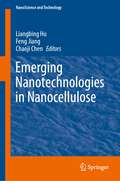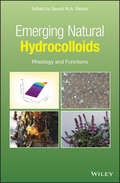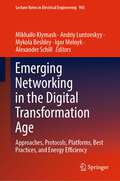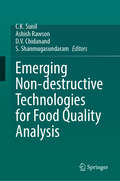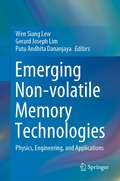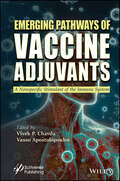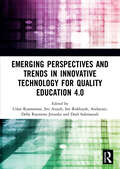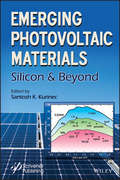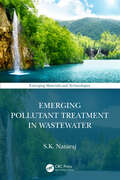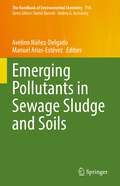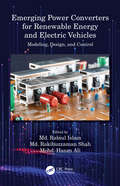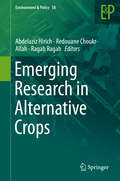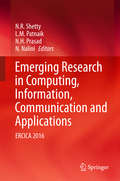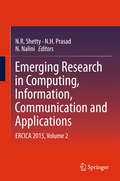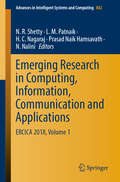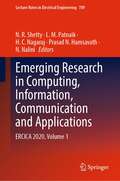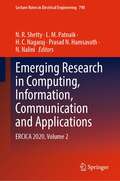- Table View
- List View
Emerging Nanomaterials: Opportunities and Challenges in Forestry Sectors
by Azamal Husen Hamid R. Taghiyari Jeffrey J. MorrellBio-based materials, including those containing wood, will become increasingly important as we move to a bio-based economy. Among their many attributes, it is vitally important that these materials are renewable, sustainable with proper management and environmentally benign. Wood remains one of our most important bio-based materials. While it is an amazing material, wood still has negative attributes and drawbacks that can affect performance, including dimensional instability when wetted, vulnerability to fire and high temperatures, and susceptibility to biodeterioration. A variety of treatments have been developed to overcome these weaknesses. Among the most exciting of these treatments are nanomaterials. These materials have some exceptionally attractive properties for improving timber performance and have been the subject of intensive research over the past decade. There is a tremendous need for a single comprehensive source of information on this rapidly emerging subject with tremendous potential to enhance the performance of a variety of bio-based materials. This book contains 10 chapters, each compiled by different author(s) who are considered the top researcher(s) in their respective fields. The chapters begin with some basic background on nanomaterials and their synthesis, then explore different areas for potential applications and conclude with a review of the emerging questions about nanomaterial safety. The book is designed to provide the latest information and know-how on application and utilization of different nanomaterials to improve the properties of wood and wood-based composite panels. The contents cover some main topics in the industry including improving physical and mechanical properties, increasing resistance to biodegradation (including fungi and insects), developing wood-plastic composites (WPC), applying nanomaterials in paper and board industry, and emergence of transparent wood and radiation shielding. It also covers the use of nanomaterials to improve the performance of paints and finishes used for forest products. The book provides a single location for those interested in the field to begin.
Emerging Nanotechnologies in Nanocellulose (NanoScience and Technology)
by Liangbing Hu Feng Jiang Chaoji ChenThis book provides expert coverage of the current state of the art in the application of nanotechnologies to cellulose research. It offers a comprehensive collection of topics including nanocellulose isolation, assembly into hierarchical structures, and advanced emerging applications. During the past decades, research in nanocellulose has advanced quickly, driven by the urgent needs for sustainability and the availability of advanced nanotechniques. Although cellulose has been investigated and used for thousands of years, the recent advances in nanotechnology have transformed our view of this natural substance. Cellulose, when present in the highly crystalline nanoscale form, can demonstrate interesting mechanical, optical, and fluidic properties that can be manipulated in designing materials with novel applications.This book contains 12 chapters. Chapter 1 focuses primarily on the fundamentals of nanocellulose, including general aspects on its structure, isolation, and characterization. Chapters 2-4 summarize the recent progress on assembly of nanocellulose into the macroscopic scale using state-of-the-art techniques. Chapters 5-13 cover the most advanced applications of nanocellulose in emerging areas, including superstrong materials, light management, electronics, energy storage, printed battery, water treatment, nanogenerator, and biomedicine. The book will appeal to upper undergraduate and graduate students through practicing researchers as a comprehensive reference on the subject of nanocellulose and its use in various fields.
Emerging Natural Hydrocolloids: Rheology and Functions
by Seyed M.A. RazaviThe first guide devoted to the functions, structures, and applications of natural hydrocolloids In today’s health-conscious climate, the demand for natural food products is growing all the time. Natural hydrocolloids, therefore, have never been more popular. With their thickening, stabilizing, gelling, fat replacing, and binding qualities, these naturally occurring, plant-based polymers can fulfil many of the same functions as commercial ingredients like xanthan, guar, gum Arabic, pectin, and starch. Moreover, certain health benefits have been linked with their often biological active compounds and high-fiber compositions, including potential prebiotic effects and the reduction of blood cholesterol levels. Application of these novel hydrocolloids is, however, still underexplored. Emerging Natural Hydrocolloids aims to remedy this by providing a thorough overview of their structure–function relationships, rheological aspects, and potential utility in mainly the food and pharmaceutical industries. This accessible, quick-reference guide features: A comprehensive and up-to-date survey of the most significant research currently available on natural hydrocolloids Examinations of the major functions and rheological aspects of novel hydrocolloids Information on the potential applications of biopolymers within both foods and pharmaceutical systems Collaborations from an international team of food scientists Emerging Natural Hydrocolloids: Rheology and Functions offers scientists, engineers, technologists, and researchers alike a unique and in-depth account of the uncharted world of novel hydrocolloids, their uses, properties, and potential benefits.
Emerging Networking in the Digital Transformation Age: Approaches, Protocols, Platforms, Best Practices, and Energy Efficiency (Lecture Notes in Electrical Engineering #965)
by Andriy Luntovskyy Alexander Schill Mikhailo Klymash Mykola Beshley Igor MelnykThis book covers a range of leading-edge topics. It is suitable for teaching specialists for advanced lectures in the domains of systems architecture and distributed platforms. Furthermore, it serves as a basis for undergraduates as well as an inspiration for interesting postgraduates, looking for new challenges. It addresses a holistic view of QoS, which becomes nowadays via Digital Transformations less technically and more socially driven. This includes IoT, energy efficiency, secure transactions, blockchains, and smart contracting. Under the term Emerging Networking (EmN), we cover the steadily growing diversity of smart mobile and robotic apps and unmanned scenarios (UAV). EmN supports distributed intelligence across the combined mobile, wireless, and fixed networks in the edge-to-cloud continuum. The 6G driving factors and potentials in the mid-term are examined. Operative (emergency) networking, which assists rescue troops at sites, also belongs to the above-mentioned problems. The EmN architecture includes the components of SDN, blockchain, and AI with efficient slicing and cloud support. The design peculiarities in dynamically changing domains, such as Smart Shopping/Office/Home, Context-Sensitive Intelligent apps, are discussed. Altogether, the provided content is technically interesting while still being rather practically oriented and therefore straightforward to understand. This book originated from the close cooperation of scientists from Germany, Ukraine, Israel, Switzerland, Slovak Republic, Poland, Czech Republic, South Korea, China, Italy, North Macedonia, Azerbaijan, Kazakhstan, France, Latvia, Greece, Romania, USA, Finland, Morocco, Ireland, and the United Kingdom. We wish all readers success and lots of inspiration from this useful book!
Emerging Non-Volatile Memories
by Seungbum Hong Orlando Auciello Dirk WoutersThis book is an introduction to the fundamentals of emerging non-volatile memories and provides an overview of future trends in the field. Readers will find coverage of seven important memory technologies, including Ferroelectric Random Access Memory (FeRAM), Ferromagnetic RAM (FMRAM), Multiferroic RAM (MFRAM), Phase-Change Memories (PCM), Oxide-based Resistive RAM (RRAM), Probe Storage, and Polymer Memories. Chapters are structured to reflect diffusions and clashes between different topics. Emerging Non-Volatile Memories is an ideal book for graduate students, faculty, and professionals working in the area of non-volatile memory. This book also: Covers key memory technologies, including Ferroelectric Random Access Memory (FeRAM), Ferromagnetic RAM (FMRAM), and Multiferroic RAM (MFRAM), among others. Provides an overview of non-volatile memory fundamentals. Broadens readers' understanding of future trends in non-volatile memories.
Emerging Non-destructive Technologies for Food Quality Analysis
by S. Shanmugasundaram Ashish Rawson C. K. Sunil D. V. ChidanandNon-destructive quality analysis refers to a method of food testing that is designed explicitly to eliminate the potential of damage to the food quality. There are various techniques by which this approach may be applied, all of which are being used recently for quality analysis, which provides important information on food characteristics such as texture, structure, and mechanical, physical and chemical properties. Conventional methods of quality analysis are time consuming, expensive and invasive in nature, particularly for long-duration analysis. Non-destructive methods have thus become highly appealing for their potential to reduce cost and waste and to shorten processing times. These approaches not only preserve the integrity of the product but also expedite the analysis process. The most common non-destructive methods used include machine vision, Spectroscopy, E-nose/tongue, Ultrasonics, and hyperspectral imaging, among others. While these methods have been in practice for some time, the technological advancements of the last decade have improved the precision and reliability of these tools, making them more popular. An overview of the dominant non-destructive methods, including the more novel technologies such as biosensors and terahertz application, have not until now been comprehensively covered in the form of a research volume. Emerging Non-destructive Technologies for Food Quality Analysis brings together detailed information on all these most current advances in technology and elucidates their application in food processing. Covering theory, principle, recent advances and practical applications in food analysis, this book will be an invaluable reference for students, researchers, food trainers and industry personnel.
Emerging Non-volatile Memory Technologies: Physics, Engineering, and Applications
by Wen Siang Lew Gerard Joseph Lim Putu Andhita DananjayaThis book offers a balanced and comprehensive guide to the core principles, fundamental properties, experimental approaches, and state-of-the-art applications of two major groups of emerging non-volatile memory technologies, i.e. spintronics-based devices as well as resistive switching devices, also known as Resistive Random Access Memory (RRAM). The first section presents different types of spintronic-based devices, i.e. magnetic tunnel junction (MTJ), domain wall, and skyrmion memory devices. This section describes how their developments have led to various promising applications, such as microwave oscillators, detectors, magnetic logic, and neuromorphic engineered systems. In the second half of the book, the underlying device physics supported by different experimental observations and modelling of RRAM devices are presented with memory array level implementation. An insight into RRAM desired properties as synaptic element in neuromorphic computing platforms from material and algorithms viewpoint is also discussed with specific example in automatic sound classification framework.
Emerging Organic Contaminants in Soil: Properties, Translocation, and Remediation (Emergent Environmental Pollution)
by Ming Zhang Mahtab AhmadEmerging organic contaminants (EOCs) are either newly identified or newly detected contaminants that are toxic or potentially hazardous to the ecosystem. The EOCs include, but are not limited to, pharmaceuticals and personal care products (PPCPs), antibiotics, perfluoroalkyl sulfonate (PFAS), flame retardants, endocrine disruptors, etc., presenting new challenges for scientists, policymakers, and the public. Soil is one of the most important sinks of EOCs arising from industrial emissions, incidental discharge, wastewater irrigation, or atmospheric deposition. The presence of EOCs in soil may threaten the soil ecosystem’s health and subsequently transfer to humans via food and water consumption. This book provides comprehensive knowledge on the behavior and translocation of EOCs in soil and the related environmental medium and introduces remediation methods and technologies. From fundamentals to future risks, it explains the importance of understanding EOCs.Features: Provides a comprehensive overview of EOCs in environmental systems. Covers comprehensively the physical, chemical, and biological processes of EOCs in soil. Addresses innovative remediation and management approaches of EOC-contaminated sites. Is the first well-organized book on EOC written by international experts with long engagement in EOC studies. This book is an excellent foundational text for upper-level undergraduate and graduate students taking courses in soil science, environmental science, environmental chemistry, social ecology, and waste management. It is also essential for those who work with environmental hazards such as environmental engineers, ecologists, environmental professionals, and managers.
Emerging Pathways of Vaccine Adjuvants: A Nonspecific Stimulant of the Immune System
by Vasso Apostolopoulos Vivek P. ChavdaThe book presents invaluable insights into the latest advancements, challenges, and research on vaccine adjuvants, which are key to developing more effective and safer vaccines essential for tackling pressing global health challenges. Emerging Pathways of Vaccine Adjuvants: A Nonspecific Stimulant of the Immune System aims to drive progress in vaccine research, paving the way for the development of more potent and safer vaccines to address global health threats. This volume provides a comprehensive overview of the evolving landscape of vaccine adjuvants, encompassing a wide range of topics critical to their design, development, and application. Adjuvants play a crucial role in vaccine formulations by boosting the immunogenicity of antigens, thereby enhancing vaccine efficacy. While antigens can initiate immune responses independently, adjuvants amplify these responses. Extensive research efforts are focused on the formulation of adjuvants to establish accurate, efficient, and safe manufacturing techniques. This book provides a clear explanation of the strict regulatory issues, making it an essential resource for students, businesspeople, and academics across the globe. Readers will find the book: Encompasses current adjuvant usage and possible tactics to ensure effective production and delivery of the active constituent; Presents challenges and innovations with implications to provide cheaper, more efficient solutions in the industry; Prepares students for work in the industry, refining their skills for the production of critical medications. Audience Researchers and pharmacy students in biomedical engineering and chemical engineering, biotechnology, as well as pharmaceutical and biopharmaceutical industry engineers working in drug discovery, chemical biology, computational chemistry, medicinal chemistry, and bioinformatics.
Emerging Perspectives and Trends in Innovative Technology for Quality Education 4.0: Proceedings of the 1st International Conference on Innovation in Education and Pedagogy (ICIEP 2019), October 5, 2019, Jakarta, Indonesia
by Siti Aisyah Isti Rokhiyah Andayani Della Raymena Jovanka Dodi Sukmayadi Udan KusmawanIndustrial Revolution 4.0 has dramatically changed the business and social landscape, including human behavior not only in advanced countries but also in emerging countries. Technology development affects many aspects in our society, including education. Distance learning, big data and analytics, artificial intelligent and many digital innovations have been released to improve better quality education in our society. These proceedings provide selected papers/research about innovative digital technology in education and pedagogy in Industrial revolution 4.0 covering issues like: pedagogy, education management, early childhood education, research in education, training and vocational education and social science education, earth science education and art/linguistic education related to digital innovation.This book provides details beyond what is possible to be included in an oral presentation and constitute a concise but timely medium for the dissemination of recent research results. It will be invaluable to professionals and academics in the field of education and pedagogy to get an understanding of recent research.
Emerging Photovoltaic Materials: Silicon & Beyond
by Santosh K. KurinecThis book covers the recent advances in photovoltaics materials and their innovative applications. Many materials science problems are encountered in understanding existing solar cells and the development of more efficient, less costly, and more stable cells. This important and timely book provides a historical overview, but concentrates primarily on the exciting developments in the last decade. It includes organic and perovskite solar cells, photovoltaics in ferroelectric materials, organic-inorganic hybrid perovskite, materials with improved photovoltaic efficiencies as well as the full range of semiconductor materials for solar-to-electricity conversion, from crystalline silicon and amorphous silicon to cadmium telluride, copper indium gallium sulfide selenides, dye sensitized solar cells, organic solar cells, and environmentally-friendly copper zinc tin sulfide selenides.
Emerging Pollutant Treatment in Wastewater (Emerging Materials and Technologies)
by S.K. NatarajThis book highlights the innovations and techniques to identify and treat the emerging pollutants in waste and polluted water. It initiates with classification of emerging pollutants followed by a review on existing detection and elimination techniques, and current regulations in place. Subsequent chapters cover membrane-based separation process, polymer-based or resin-based water filters, functional materials, nanomaterials-based adsorbents, microplastics, and summary of the potential solutions in treating or removing emerging pollutants. Features Presents an overview of current and developing treatment technologies for water polluted with emerging pollutants Gives in-depth account and analysis of advanced materials and methods for separation and treatment Reviews analytical techniques applied to detect emerging pollutants Discusses overall effect of policies on current chemicals/plastics/APIs in the market Includes pertinent case studies and regulations The book is aimed at researchers, professionals and graduate students in environmental/civil/chemical engineering, wastewater/drinking water treatment.
Emerging Pollutants in Sewage Sludge and Soils (The Handbook of Environmental Chemistry #114)
by Avelino Núñez-Delgado Manuel Arias-EstévezThis book provides an authoritative overview of emerging pollutants in sewage sludge and soils. It traces the latest research and new trends on the characterization, removal and treatment of such pollutants in urban and industrial sewage sludge and soils. The book covers topics such as antibiotic resistance, fate and environmental impact of contaminants of emerging concern, environmental transmission of human pathogenic viruses and their effect on soil, and the repercussion of various emerging pollutants on biodiversity. It also offers a case study of the epidemiology-based surveillance of SARS-CoV-2 in wastewater and sludge. The book appeals not only to researchers and professionals working with emerging contaminants, but also to policy makers and a broader audience interested in learning more about the effects of these contaminants in human and environmental health.
Emerging Pollutants: Protecting Water Quality for the Health of People and the Environment (Advances in Water Security)
by Ali Fares Gabriel Eckstein Sarantuyaa ZandaryaaThis open access book focuses on the importance of reducing pollution and protecting water resources for the health of people and the environment. Water is vital for life on Earth. The quality of the world's freshwater resources is deteriorating due to the rise in pollution levels, which puts the health of people and the environment at risk. Emerging pollutants, a new class called Contaminants of Emerging Concern, pose a global water quality challenge. The identification and implementation of appropriate regulatory, monitoring, prevention, and control measures are hindered by limited scientific understanding and knowledge about sources and pathways of emerging pollutants, their behaviour and fate in the environment, and potential human and ecosystem health risks. The book presents selected contributions to the UNESCO-IWRA Online Conference “Emerging Pollutants: Protecting Water Quality for the Health of People and the Environment,” held on 17–19 January 2023. It offers an extensive overview of current research findings on emerging pollutants in aquatic ecosystems, groundwater contamination, wastewater management and reuse, circular economy approaches to pollutant lifecycle management, and the prioritization of emerging pollutants in the hydro-cycle. Based on scientific evidence and policy-relevant research findings, the book’s concluding chapter highlights research and policy gaps, offering recommendations for strategic and practical ways to manage emerging pollutants towards sustainable water management in the face of global changes and evolving environmental threats. This book is a scientific output in the framework of UNESCO Intergovernmental Hydrological Programme’s Ninth Phase “Science for a Water-Secure World in a Changing Environment” (IHP-IX, 2022-2029) and UNESCO-IHP’s International Initiative on Water Quality (IIWQ) in collaboration with the International Water Resources Association (IWRA).
Emerging Power Converters for Renewable Energy and Electric Vehicles: Modeling, Design, and Control
by Md. Rabiul Islam Md. Rakibuzzaman Shah Mohd Hasan AliThis book covers advancements of power electronic converters and their control techniques for grid integration of large-scale renewable energy sources and electrical vehicles. Major emphasis is on transformer-less direct grid integration, bidirectional power transfer, compensation of grid power quality issues, DC system protection and grounding, interaction in mixed AC/DC systems, AC and DC system stability, design of high-frequency high power density systems with advanced soft magnetic materials, modeling and simulation of mixed AC/DC systems, switching strategies for enhanced efficiency, and protection and reliability for sustainable grid integration. This book is an invaluable resource for professionals active in the field of renewable energy and power conversion. Md. Rabiul Islam received his PhD from the University of Technology Sydney (UTS), Australia. He was appointed as a Lecturer at Rajshahi University of Engineering & Technology (RUET) in 2005 and promoted to full-term Professor in 2017. In early 2018, he joined the School of Electrical, Computer, and Telecommunications Engineering, University of Wollongong, Australia. He is a Senior Member of IEEE. His research interests include the fields of power electronic converters, renewable energy technologies, power quality, electrical machines, electric vehicles, and smart grids. He has authored or coauthored more than 200 publications including 50 IEEE Transactions/IEEE Journal papers. He has been serving as an editor for IEEE Transactions on Energy Conversion and IEEE Power Engineering Letters, and associate editor for IEEE Access. Md. Rakibuzzaman Shah is a Senior Lecturer with the School of Engineering, Information Technology and Physical Science at Federation University Australia. He has worked and consulted with distribution network operators and transmission system operators on individual projects and has done collaborative work on a large number of projects (EPSRC project on multi-terminal HVDC, Scottish and Southern Energy multi-infeed HVDC) - primarily on the dynamic impact of integrating new technologies and power electronics into large systems. He is an active member of the IEEE and CIGRE. He has more than 70 international publications and has spoken at the leading power system conferences around the world. His research interests include future power grids (i.e., renewable energy integration, wide-area control), asynchronous grid connection through VSC-HVDC, application of data mining in power system, distribution system energy management, and low carbon energy systems. Mohd. Hasan Ali is currently an Associate Professor with the Electrical and Computer Engineering Department at the University of Memphis, USA, where he leads the Electric Power and Energy Systems (EPES) Laboratory. His research interests include advanced power systems, smart-grid and microgrid systems, renewable energy systems, and cybersecurity issues in modern power grids. Dr. Ali has more than 190 publications, including 2 books, 4 book chapters, 2 patents, 60 top ranked journal papers, 96 peer-reviewed international conference papers, and 20 national conference papers. He serves as the editor of the IEEE Transactions on Sustainable Energy and IET-Generation, Transmission and Distribution (GTD) journal. Dr. Ali is a Senior Member of the IEEE Power and Energy Society (PES). He is also the Chair of the PES of the IEEE Memphis Section.
Emerging Radiation Detection: Technology and Applications
by Kris Iniewski Harish GadeyThis book provides readers an overview of emerging trends in the radiation detection field. Detailed in many of the chapters are specific aspects of radiation detectors, including comprehensive reviews of the historical development, and current state of each topic. The authors particularly cover emerging detection materials and detectors. High-Z materials like CdTe, CZT and GaAs offer the best implementation possibility of direct conversion X-ray detectors and are covered in this book. The authors discuss material challenges, detector operation physics and technology, and readout integrated circuits required to detect signals processes by high-Z sensors. Authors also contrast these emerging technologies with more established ones based on scintillator materials.
Emerging Research in Alternative Crops (Environment & Policy #58)
by Ragab Ragab Redouane Choukr-Allah Abdelaziz HirichThis book provides case studies on cultivating alternative crops and presents new cropping systems in many regions of the world. It focusses on new emerging research topics aiming to study all aspects of adaptation under several stresses including agricultural, environmental, biological and socioeconomic issues. The book also provides operational and practical solutions for scientists, producers, technology developers and managers to succeed the cultivation of new alternative crops and, consequently, to achieve food security.Many regions in the world are suffering from water scarcity, soil and water salinization and climate change. These conditions make it difficult to achieve food security by cultivating conventional crops. A renaissance of interest for producing alternative crops under water scarcity and water salinization has been, therefore, implemented primarily among small-scale producers, researchers and academics.The use of alternative crops (quinoa, amaranth, legume crops, halophytes, …etc.) may provide some environmental benefits such as valorization of salt-affected soils, reduced pesticide application, enhanced soil and water quality and promotion of wildlife diversity. This also may provide some economic benefits such as providing the opportunity for producers to take advantage of new markets and premium prices, spreading the economic risk and strengthening local economies and communities. Furthermore, alternative crops are often rich in proteins and minerals, and even some of them are Gluten free (quinoa). This reflects their importance to achieve food security in quantity and quality scale. The year 2013 was exceptional for alternative crops as it was the international year of quinoa celebrated by Food and Agriculture Organization (FAO). This reflects the importance of research conducted on quinoa and other alternative crops in many regions of the world.
Emerging Research in Computing, Information, Communication and Applications
by N. R. Shetty N. H. Prasad N. Nalini L. M. PatnaikThis book presents the proceedings of International Conference on Emerging Research in Computing, Information, Communication and Applications, ERCICA 2016. ERCICA provides an interdisciplinary forum for researchers, professional engineers and scientists, educators, and technologists to discuss, debate and promote research and technology in the upcoming areas of computing, information, communication and their applications. The book discusses these emerging research areas, providing a valuable resource for researchers and practicing engineers alike.
Emerging Research in Computing, Information, Communication and Applications
by N. R. Shetty N. Nalini N Hamsavath PrasadThis proceedings volume covers the proceedings of ERCICA 2015. ERCICA provides an interdisciplinary forum for researchers, professional engineers and scientists, educators, and technologists to discuss, debate and promote research and technology in the upcoming areas of Computing, Information, Communication and their Applications. The contents of this book cover emerging research areas in fields of Computing, Information, Communication and Applications. This will prove useful to both researchers and practicing engineers.
Emerging Research in Computing, Information, Communication and Applications
by N. R. Shetty N. H. Prasad N. NaliniThis proceedings volume covers the proceedings of ERCICA 2015. ERCICA provides an interdisciplinary forum for researchers, professional engineers and scientists, educators, and technologists to discuss, debate and promote research and technology in the upcoming areas of Computing, Information, Communication and their Applications. The contents of this book cover emerging research areas in fields of Computing, Information, Communication and Applications. This will prove useful to both researchers and practicing engineers.
Emerging Research in Computing, Information, Communication and Applications: ERCICA 2018, Volume 1 (Advances in Intelligent Systems and Computing #882)
by N. R. Shetty N. Nalini L. M. Patnaik H. C. Nagaraj Prasad Naik HamsavathThis book presents selected papers from the International Conference on Emerging Research in Computing, Information, Communication and Applications, ERCICA 2018. The conference provided an interdisciplinary forum for researchers, professional engineers and scientists, educators, and technologists to discuss, debate and promote research and technology in the emerging areas of computing, information, communication and their applications. The book discusses these research areas, providing a valuable resource for researchers and practicing engineers alike.
Emerging Research in Computing, Information, Communication and Applications: ERCICA 2018, Volume 2 (Advances in Intelligent Systems and Computing #906)
by N. R. Shetty N. Nalini L. M. Patnaik H. C. Nagaraj Prasad Naik HamsavathThis book presents selected papers from the International Conference on Emerging Research in Computing, Information, Communication and Applications, ERCICA 2018. The conference provided an interdisciplinary forum for researchers, professional engineers and scientists, educators, and technologists to discuss, debate and promote research and technology in the emerging areas of computing, information, communication and their applications. The book discusses these research areas, providing a valuable resource for researchers and practicing engineers alike.
Emerging Research in Computing, Information, Communication and Applications: ERCICA 2020, Volume 1 (Lecture Notes in Electrical Engineering #789)
by N. R. Shetty N. Nalini L. M. Patnaik H. C. Nagaraj Prasad N. HamsavathThis book presents the proceedings of International Conference on Emerging Research in Computing, Information, Communication and Applications, ERCICA 2020. The conference provides an interdisciplinary forum for researchers, professional engineers and scientists, educators and technologists to discuss, debate and promote research and technology in the upcoming areas of computing, information, communication and their applications. The book discusses these emerging research areas, providing a valuable resource for researchers and practicing engineers alike.
Emerging Research in Computing, Information, Communication and Applications: ERCICA 2020, Volume 2 (Lecture Notes in Electrical Engineering #790)
by N. R. Shetty N. Nalini L. M. Patnaik H. C. Nagaraj Prasad N. HamsavathThis book presents the proceedings of International Conference on Emerging Research in Computing, Information, Communication and Applications, ERCICA 2020. The conference provides an interdisciplinary forum for researchers, professional engineers and scientists, educators and technologists to discuss, debate and promote research and technology in the upcoming areas of computing, information, communication and their applications. The book discusses these emerging research areas, providing a valuable resource for researchers and practicing engineers alike.
Emerging Research in Computing, Information, Communication and Applications: Proceedings of ERCICA 2022 (Lecture Notes in Electrical Engineering #928)
by N. R. Shetty N. H. Prasad L. M. PatnaikThis book presents the proceedings of the International Conference on Emerging Research in Computing, Information, Communication and Applications, ERCICA 2022. The conference provides an interdisciplinary forum for researchers, professional engineers and scientists, educators, and technologists to discuss, debate, and promote research and technology in the upcoming areas of computing, information, communication, and their applications. The book discusses these emerging research areas, providing a valuable resource for researchers and practicing engineers alike.

